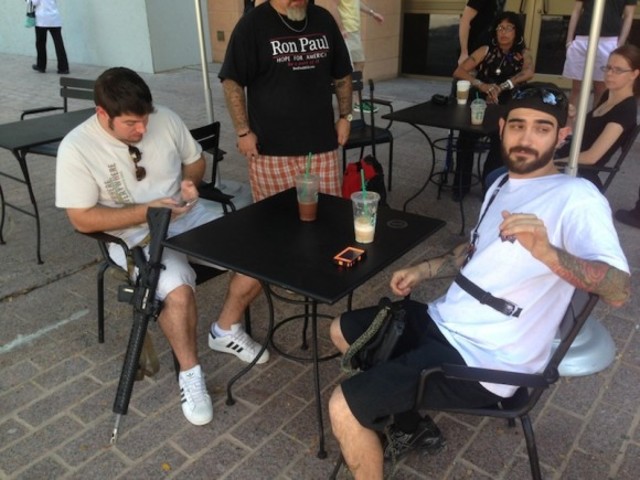Last week, about 40 members of Open Carry Texas, a gun-rights group, assembled in the parking lot of the Arlington restaurant where a gun-control group was meeting and pulled out their semi-automatic weapons. Openly carrying such weapons is legal in Texas, and the demonstrators see “open carry counterdemonstrations” as an exercise in their First Amendment, rather than Second Amendment rights. No one has been prosecuted, but, given the latent confrontation inherent in the demonstrations, police intervention almost seems invited. If the constitutional issue ever did appear in court, it likely would hinge on whether the demonstrators speech and actions constitute a threat. And that probably depends on which end of the barrel you’re on.
When questions like this arise, the set of rules that’s supposed to tell us what’s legal and what isn’t, what’s constitutional and what isn’t, can become irrelevant. Whether or not you believe, as a matter of law, that carrying guns as part of a demonstration directed at a people who are afraid of guns (so they can see that it’s harmless to carry guns) constitutes a true threat likely depends on how you, personally, feel about guns. When cases hinge on ideas that are not only subjective, but also deeply felt, it becomes possible for rational—or seemingly rational—legal determinations to be eclipsed by emotional responses. When people say hard cases can make bad law, this is what they’re talking about.
Dahlia Lithwick (who also covered the Open Carry Texas story) made this point more beautifully than I could in The New York Times in 2002. Lithwick’s piece was triggered by an uncharacteristic outburst during oral argument from Justice Clarence Thomas, whose typical manner at arguments resembles that of a decorative bust. The case, Virginia v. Black, also concerned freedom of speech and asked the Court to decide whether cross-burning was protected by the First Amendment. Justice Thomas, who grew up in segregated Georgia, interrupted not with a question, but to make clear his own position that cross-burning was not speech: It had no “communication, no particular message” and served as a symbol only of a “reign of terror,” of “100 years of lynchings.” Lithwick writes:
[W]ith his personal narrative, Justice Thomas changed the terms of the legal debate. After he spoke, members of the court took turns characterizing burning crosses as uniquely threatening symbolic speech—as threatening as a gun, according to Justice Antonin Scalia—and as therefore undeserving of First Amendment protection. The dynamic is familiar to any former law student: A criminal law class on the definition of “consent” in a rape case is paralyzed when a woman in the back row says she was raped. A policy debate about whether to try juvenile offenders as adults stops when a student blurts out that his brother was killed in a gang fight.
These awkward silences happen when legal analysis and personal narrative (often of victimization) collide. At these moments, law school professors are rendered speechless—and Supreme Court justices, evidently, jettison their three-part tests to reassure their distressed colleague that indeed burning crosses are uniquely symbolic of imminent violence.
In the end, the Court hedged in Black. Cross-burning with intent to intimidate is not protected speech, but cross-burning without intent to intimidate (whatever that means) is protected speech. Justice Thomas dissented, arguing as he had in court that cross-burning is not speech at all, but that it is calculated and horrifying intimidation. Thomas has not spoken about the extent to which his legal opinion on cross-burning derives from his personal history, and nor has Justice John Paul Stevens in a dissent widely believed to be shaped by his individual worldview. In Texas v. Johnson, the 1989 First Amendment challenge to a flag-burning ban, Justice Stevens’ dissent argued that flag burning is not constitutionally protected speech. That dissent “is usually hailed as the emotional decision of a loyal former soldier whose military experience changed him forever.”
Despite their years of emotional denaturing on the bench of the federal judiciary, “where even the most harrowing personal narrative is usually bleached out to clinical analysis and citation to precedent,” it is impossible to believe that Supreme Court justices shed the systems of beliefs and values that guide their lives outside of the courtroom when they step into it (in fact, there is an entire school of legal thought dedicated to arguing that none of us do). The question is how to use the humanity of the court to its advantage without sacrificing the rule of law. As Lithwick noted about the Black case: “[W]hat if this case were about swastikas and no Holocaust survivor were on the court? Would the justices be so quick to deny death-row appeals if one of them had a son scheduled for execution?”
Back in 2002, Lithwick concluded that the only solution is a judicial bench as diverse as its jurisdiction. That would be great, but I think it’s that hobgoblin of the 2009 Supreme Court appointment process: empathy. The members of even the most diverse bench can still fall into the emotional trap of their own individual perspectives, but the ability to understand the positions of others could help them find the trapdoor.
Bree Bernwanger is a lawyer and writer based in New York. She holds degrees from the University of Texas and Georgetown Law.
Photo: KXAN, Open Carry group carries rifles in downtown Austin.









